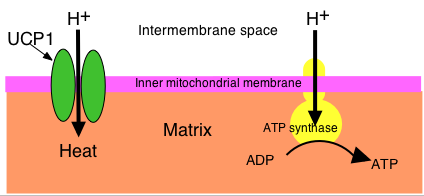White adipose tissue is the most common and is the fat that so many of us complain of acquiring.
Brown adipose tissue is present in small mammals (e.g., mice) and in newborn humans. Most of it disappears in adult humans.
The cells in both types of fat are called adipocytes although they differ in origin, structure, and function in the two types of tissue.
| WAT Adipocytes | BAT Adipocytes |
| a narrow rim of cytoplasm with its nucleus pressed near the margin of the cell surrounding | Cytoplasm throughout the cell with a central nucleus and |
| a single large membrane-enclosed lipid droplet [View] | many small lipid droplets |
| few mitochondria | many mitochondria (providing the brown color) |
| modest blood supply | rich blood supply |
| serves as a depot of stored energy | function is to generate heat |
New adipocytes in white adipose tissue are formed throughout life from a pool of precursor cells. These are needed to replace those that die (after an average life span of 10 years). They are probably also at least partially responsible for the increase in the volume of fat tissue e.g., in obesity. However, an increase in the size of individual adipocytes as they become filled with oil also contributes.
The adipocytes of white adipose tissue secrete several hormones, including:In addition to serving as a major source of energy reserves, white adipose tissue also provides some mechanical protection and insulation to the body. Obesity is the excessive accumulation of white adipose tissue.
Brown adipose tissue provides a vital source of heat to maintain body temperature in small mammals (with their high surface to volume ratio) and infants (who usually cannot shiver when they are cold).
Brown adipose tissue is activated when the body temperature drops. This is the mechanism:
So instead of cellular respiration (of fatty acids and glucose) generating ATP, it generates heat instead.
Lean adult humans have deposits of beige cells in the neck and upper chest regions. When they are exposed to cold, their beige cells are activated. Obese people have few or no beige cells. Probably their layers of white adipose tissue provide such good insulation that they are in less danger of heat loss.
| Welcome&Next Search |